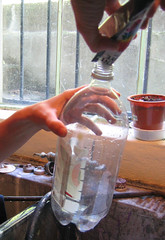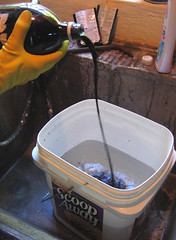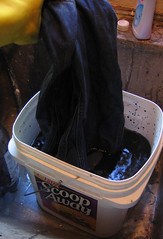Over-Dyeing Denim
 Dark denim is trendy and slimming. However, if your denim wardrobe consists of entirely faded or stonewashed denim, you don’t need to buy new jeans. For about $5 a pair, you can overdye them at home.
Dark denim is trendy and slimming. However, if your denim wardrobe consists of entirely faded or stonewashed denim, you don’t need to buy new jeans. For about $5 a pair, you can overdye them at home.Based on the recommendation of a Dylon promotional pamphlet, I use one package each of black and indigo Dylon Permanent Fabric Dye to darken my denim. Each packet dyes 1/2 lb (8 oz) dry fabric, so the two packets will usually only dye one pair of adult jeans. This dye can be used on cotton, linen, ramie and rayon.
Materials required:
1 package black Dylon Permanent Fabric Dye
1 package indigo Dylon Permanent Fabric Dye
Warm water
1/2 C salt
Bucket large enough for the fabric to move in freely when filled with water
Empty, clean soda bottle (2 Liter) or milk jug (1/2 gallon or larger)
Rubber gloves
Stirring implement
Timer
Below you’ll find the instructions from the dye packet (italicized), along with photos and my notes.
INSTRUCTIONS. Wear rubber gloves.
Really – wear rubber gloves. Otherwise, you’ll dye your skin and it is difficult to remove.
1. Weigh dry fabric. Wash thoroughly, even if new, to remove stains or sizing which may not be visible to the naked eye. Leave damp.
I don’t have a kitchen scale, but using the crude method of weighing myself with and without the skirt on a bathroom scale, I figured that the skirt weighed approximately 12 ounces, dry.
 2. Dissolve contents of this pack in 4 cups of warm water, stirring thoroughly.
2. Dissolve contents of this pack in 4 cups of warm water, stirring thoroughly.I empty the 2 packets into the soda bottle or milk jug and add the 8 cups of warm water. Then, I cap the container and shake to thoroughly mix the dye.
3. Fill a flat-bottomed bowl or stainless steel sink with enough warm water for fabric to move freely.
As you’ll be able to tell from the photos, I use an empty, clean kitty litter bucket for dyeing. We have plenty of these stored in the basement and I’ve found that the dye doesn’t stain or even stick to the plastic, so I can use the bucket for other (non-food) purposes later.
4. Add 4 Tbsp salt to bowl. Stir to dissolve.
As I’ve doubled the “recipe,” I added 8 Tbsp (1/2 C) salt to the bucket of warm water. I use a paint stick to stir.
 5. Add the dissolved dye, stirring well.
5. Add the dissolved dye, stirring well.Not only is it easy to dissolve the dye in a capped container, but it is easy to pour too! I use my handy-dandy paint stick, again, to stir.
 6. Place damp, unfolded fabric into bowl.
6. Place damp, unfolded fabric into bowl.The fabric looks dark here because it is wet. I promise that I didn’t pull a switcheroo on you.
 7. Dye for one hour. Agitate constantly for first 15 minutes. Stir regularly for another 45 minutes, keeping the fabric submerged.
7. Dye for one hour. Agitate constantly for first 15 minutes. Stir regularly for another 45 minutes, keeping the fabric submerged.I like to use gloved hands to agitate the garment. Using a kneading motion, I ensure that the dye is thoroughly worked into the fabric. After the first 15 minute period (constant agitation), I set the timer again (for 15 minutes) and poke at/stir the fabric with the paint stick when the timer goes off. I then repeat twice more. I wouldn’t call this “regular” stirring, but it seems to work well enough.
8. Rinse fabric in cold water until water runs clear. Wash separately in hot water with usual washing detergent. For wool and silk, rinse and wash in lukewarm water.
The rinsing step is a real bitch. I’ve haven’t kept track of the number of rinsing required, but I’d guess that it is somewhere around thirty.
9. Dry away from direct heat and sunlight.
We have a clothesline in our basement, so I have an ideal place to dry the finished product.
10. Wash garment separately for first few washes to remove any excess dye.
I add the dyed jeans to my black wash loads. I figure that any excess dye won't negatively affect black clothing. To maintain the dark color for as long as possible, I wash the denim inside out and hang to dry.
 As you can see, the result is a dark, inky blue. Admittedly, it is a bit of a flatter finish than you’d find on purchased dark jeans. In my experience (with dyeing four different denim items), the stitching does not absorb the dye. I believe that is because the thread is usually a polyester blend. The labels sometimes absorb the dye and sometimes do not. Again, it depends on the fiber content.
As you can see, the result is a dark, inky blue. Admittedly, it is a bit of a flatter finish than you’d find on purchased dark jeans. In my experience (with dyeing four different denim items), the stitching does not absorb the dye. I believe that is because the thread is usually a polyester blend. The labels sometimes absorb the dye and sometimes do not. Again, it depends on the fiber content.I’ll be wearing my “new” skirt on Friday!
Labels: how to, special edition

0 Comments:
Post a Comment
Subscribe to Post Comments [Atom]
<< Home